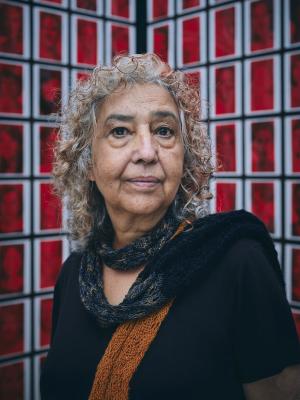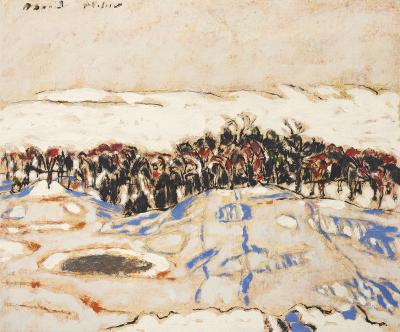Unearthing botanicals with Michelle Peraza
One of this year’s AGO X RBC Artists-in-Residence shares details about her project and her Maker Fridays session with visitors

Image courtesy of Michelle Peraza
Amate, or amatl paper, is a Mesoamerican tree bark paper used in pre-Columbian Mexico to create codices and religious clothing. In her recent AGO X RBC Artist-in-Residence project, Latinx artist Michelle Peraza reclaimed amate paper and other materials, critically reflecting on plant life and the complex history of botanical imagery. The result is two large-scale mixed media drawings – currently in process – featuring botanical imagery and traditional Mesoamerican patterns.
In September 2024, Peraza facilitated an AGO Maker Fridays event and invite visitors to join her for an evening of art-making. Inspired by their experiences with botanical imagery in the AGO Collection, from their memories or imaginations, participants drew images of botanical life on long strips of amate paper. Peraza then wove these strips together, creating mixed media works incorporating drawing, cut-outs and mending.
Michelle Peraza is a visual artist of Cuban and Costa Rican descent. She explores the complexity of the Latinx experience, post-colonialism, allegory, transculturation and resilience through a research- and material-based practice.
We recently connected with Peraza to learn more about amate paper, her AGO residency, and her experience working with AGO visitors during Maker Fridays.
Foyer: With your residency project, you are responding to geological injustice as it relates to global plant life and the dissemination of botanical imagery. Can you walk us through your thought process when ideating this work?
Peraza: My interest in the role of drawing and painting in disseminating images of plant life goes back to two consecutive research/residencies trips in 2022 to Spain and Costa Rica. My aunt in Costa Rica was telling me about plants in her garden and called one “La Malinche” (a contentious figure in Mexican history; the first Nahua women to supposedly have a mestizo “mixed” child with a Spanish conquistador). This plant was the peacock flower. Through Londa Schiebinger’s writings about agnotology or deliberate ignorance, I learned about its medicinal properties and its ability to induce abortions as known by Indigenous and African women. However, as the plant moved into Europe both physically into gardens as well as through images and writing, this knowledge was not transferred.
Coming back to my ideation and process in thinking through this residency, the theme for this year is “movement” so I was thinking about mass movement of plant life as it relates to the Anthropocene (or as I prefer, the Alt-anthro-scene as explained in A Billion Black Anthropocenes or None by Kathryn Yusoff). I was also inspired by the Flora Danica, a comprehensive botanical atlas from the Danish kingdom, which the AGO acquired nine engravings of. This project then became a response to the alt-anthro-scene, the Flora Danica, colonial botanical expeditions and illustrations and processing this through strata, drawing, painting, natural dyeing, hand-stitching, braiding and cut-outs.

Image courtesy of Michelle Peraza
From amate paper to gold leaf, this work utilizes a unique collection of materials. Can you speak about what went into selecting, sourcing and incorporating the various materials you used?
Amate/amatl is a Mesoamerican tree bark paper kept alive in San Pablito, Mexico. As it was used for codices and religious clothing, it was not only mass burned in the Spanish colonial period but also banned to produce. I hope there is resilience and resistance in working with this paper on a large scale, however, there are many questions I ask myself in that by being an artist, I am also part of the extractive processes. In the residency project I was using bole, a clay-based pigment underneath traditional gilding/gold leafing. Gold has deep histories and meaning in both Mesoamerican and Spanish culture; I am thinking about empire, representations of the sun, power, currency but also extraction and labour. As the residency developed, I also hand-stitched into the paper with linen thread and naturally dyed linen, sourced from around the world, with soy milk, tamarind, hibiscus, bole, and coffee that I braid into various lengths and will weave into the work.
Can you describe in detail how you engaged with works in the AGO Collection featuring floral and botanical imagery in the process of making this work?
As I mentioned, I started with inspiration from the nine engravings of the Flora Danica and was able to see them in person. Beyond the Flora Danica, I looked at illuminated manuscripts and how botanicals appear in work on display from artists such as Christi Belcourt, Kent Monkman, Lisa Reihana, and Sarindar Dhaliwal. I had amazing support from the library where I looked at books related to Alexander von Humboldt’s expeditions, the Canadian Arctic Archipelago, and Canadian illustrations of weeds and wildflowers from the rare book collection. From all this inspiration, I created studies of plants with Beam’s paints that I would reference as I painted and cut-out onto the large-scale work.
One of the two large-scale drawings you created was in part the result of the contributions of AGO visitors during a Maker Fridays event. Can you describe what you invited visitors to create, and share some of your experience facilitating the event?
My co-creators at the Maker Friday event, as well as Open Studio for the AGO staff were given coloured pencils within the red palette inspired by bole (clay) and invited to draw plants with me; whatever plant life meant for them. I provided strips of the amate/amatl that were 8ft in length with pre-cut abstracted braid work. Both experiences were wonderful ways to talk and draw at the same time, listening to stories about the plant they were drawing and getting to know the maker. I was reminded that artmaking is a way to process and cope. I went on to cut-out elements of my collaborator’s drawings and hand-stitch the strips together to form two 8 x 4 feet works that function with my own two works. Their contributions are, therefore, entangled in the world I was inspired to create.
Stay tuned for more information on upcoming Maker Fridays events, and news about next year’s AGO X RBC Artist-in-Residence.



























